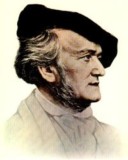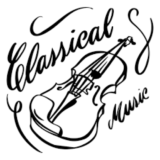THE GERMAN OPERA
VERSION FRANCAISE DISPONIBLE. VEUILLEZ CLIQUER SUR L'ICONE (BAS DE PAGE)
DEFINITION
If Beethoven opened the 19th century of German opera with " Fidelio ", it was Carl Maria von Weber (whom we saw in the chapter devoted to romantic composers) who created the first truly great German opera, both romantic and national, with " Freischütz" in 1821.
But it was with Wagner that German opera reached an unequalled peak.
WAGNER (1813-1883)

Richard Wagner was born on May 22, 1813 in Leipzig.
He composed his first opera, "Les fées", at the age of 20, influenced by Weber's "der Freitschütz".
In 1837 he was appointed conductor in Riga, where he composed his first grand opera, "Rienzi", from 1838 to 1840.
In 1839 he went to London where he began composing The Flying Dutchman, which he completed in Paris in 1841.
In 1842 he returned to Dresden for the premiere of his opera "Rienzi", and settled there with his wife Minna Planer.
From 1843 to 1849, he was Kapellmeister in Dresden where he composed “Tannhäuser” (1843-1845) and “Lohengrin” (1845-1848).
In 1849 Wagner was forced into exile in Switzerland following his participation in the May uprisings in Dresden. It was there that he wrote his works "The Artwork of the Future" (1849) and "Work and Drama" (1850-1851), in which he expounded his aesthetic ideas and his notion of the " total work of art ", uniting music, poetry and drama.
From 1852 to 1857, he composed the first operas of his Tetralogy, "The Rhinegold" in 1853-1854, then "The Valkyrie" from 1854 to 1856 and the beginning of "Siegfried" in 1857. He would not resume the composition of the Tetralogy until 12 years later.
This period saw his passionate affair with Mathilde Wesendonk, the muse who inspired him to compose “Tristan and Isolde” from 1857 to 1859.
The discovery of this affair by his wife led him to expatriate himself to Paris where he staged a new version of "Tannhäuser" which caused a scandal. Poorly received by the Parisian public, he decided to return to his country where he began in 1861 the composition of his only comic opera "The Mastersingers of Nuremberg" which he would complete in 1867. In 1864, Wagner was received in Munich by King Ludwig II of Bavaria, who became his patron.
In 1865 he created "Tristan and Isolde" in Munich, under the direction of Hans von Bülow , in the presence of Louis II of Bavaria.
From 1864, Wagner had an affair with Cosima, wife of Hans von Bülow and daughter of Franz Liszt and Marie d'Agoult.
In 1866, after the scandal of the birth of Isolde, daughter of Wagner and Cosima, he had to take refuge with her in Lucerne, where he married her in 1870. It was in Lucerne that he completed "Siegfried" in 1871. In 1872, he moved to Bayreuth where he completed his tetralogy with "The Twilight of the Gods" in 1874.
The year 1876 saw the premiere of "The Ring Cycle" at the inauguration of the Festspielhaus (Festival Palace), a theatre entirely devoted to his operas, built with the financial support of Ludwig II of Bavaria. This theatre had been designed by Wagner in 1850, in order to realise his particular conception of opera as a "total work of art".
Since then, the Bayreuth Festival has been held there every summer. It is one of the most prestigious festivals in the world, where tickets must be booked several years in advance. It exclusively performs Wagner's ten major operas, each time in new and sometimes scandalous productions.
Between 1872 and 1882, Wagner completed "Parsifal", which he had sketched in 1857, and which was also premiered in Bayreuth in 1882.
Richard Wagner died in Venice on February 13, 1883.
The total work of art
From "The Flying Dutchman" (1843) and "Tannhaüser" (1845) Wagner replaced the sequence of arias, ensembles and choruses of traditional opera with continuous music.
He gives as much importance to the orchestra as to the singers for whom aria and recitative are merged into a single song.
It introduces the leitmotif (conducting motif) which is a theme that recurs throughout the work, representing an idea or a character. (We have already encountered the leitmotif in Berlioz's Symphonie fantastique in the form of the " idée fixe ").
After "Lohengrin" (1848), he developed his theory of opera in various works ("The Work of Art of the Future", "Opera and Drama") where he defended the idea of a total work of art for which the composer wrote the libretto, the music and the staging, which he achieved with his tetralogy, "Der Ring des Nibelungen" (The Ring of the Nibelung).
His colossal orchestrations, his chromatic chords, his long melodic lines unleashed passions in the musical world of the 19th century, and everyone had to take a position for or against Wagner.
It has been said that the extreme chromaticism of "Tristan and Isolde", and in particular its first chord, inaugurated 20th century music.
The Tetralogy
the plot and characters of the tetralogy by clicking here
The Ring of the Nibelung Ring Cycle is considered the greatest operatic work of all time. It took 28 years to complete, from 1853 to 1874.
It comprises four operas (a prologue and 3 days) closely linked by the plot, and by a set of leitmotifs which reappear throughout the 4 works.
These four operas are "Das Rheingold" (The Rhinegold), "Die Walküre" (The Valkyrie), "Siegfried" and "Götterdämmerung" (The Twilight of the Gods). They are designed to be performed on four consecutive evenings, and represent a total of more than 15 hours of performance.
There are many leitmotifs representing characters, objects or ideas.
The directory
The essence of Wagner is contained in ten operas, for which Wagner himself wrote the librettos: "The Flying Dutchman" (1843), "Tannhäuser" (1845), "Lohengrin" (1850), "Tristan and Isolde" (1865), "The Mastersingers of Nuremberg" (1868), "The Rhinegold" (1869), "The Valkyrie" (1870), "Siegfried" (1876), "Götterdörde" (1876) - the last four constituting the prologue and the three days of "The Ring of the Nibelung" - and finally "Parsifal" (1882).
OTHER GERMAN COMPOSERS

In the line of Weber, we can cite Heinrich Marschner (1795-1861) whose best-known work is " Hans Heiling " (1833).
Albert Lortzing (1801-1851) was one of the leading representatives of the Germanic variant of comic opera, the Spieloper. He was the author of " der Wildschütz ".
Friedrich Flotow (1812-1883) is best known for " Martha " (1847), a romantic opera in four acts.
Otto Nicolai (1810-1849) is the author of " Die lustigen Weiber von Windsor " (1849), based on Shakespeare's "The Merry Wives of Windsor".
We can also cite Humperdinck (1854-1921) with " Hänsel und Gretel " (1893) and Richard Strauss (1864-1949) with his first opera " Guntram " (1894), two composers influenced by Wagner, and whom we will find again in the context of German post-romanticism.





